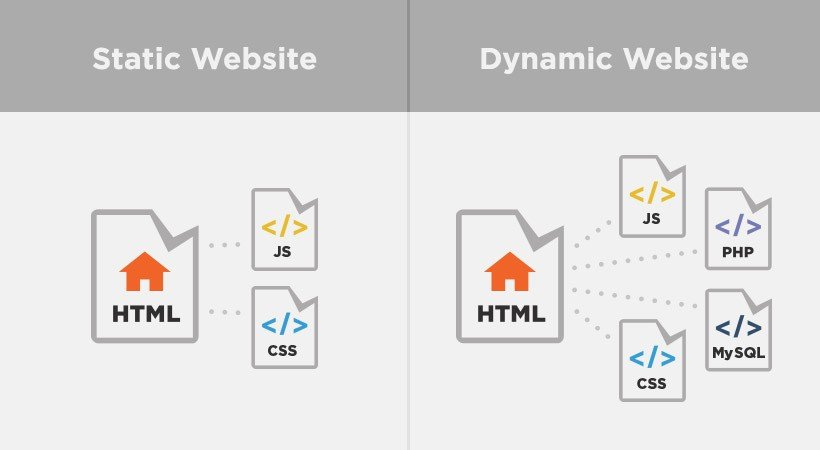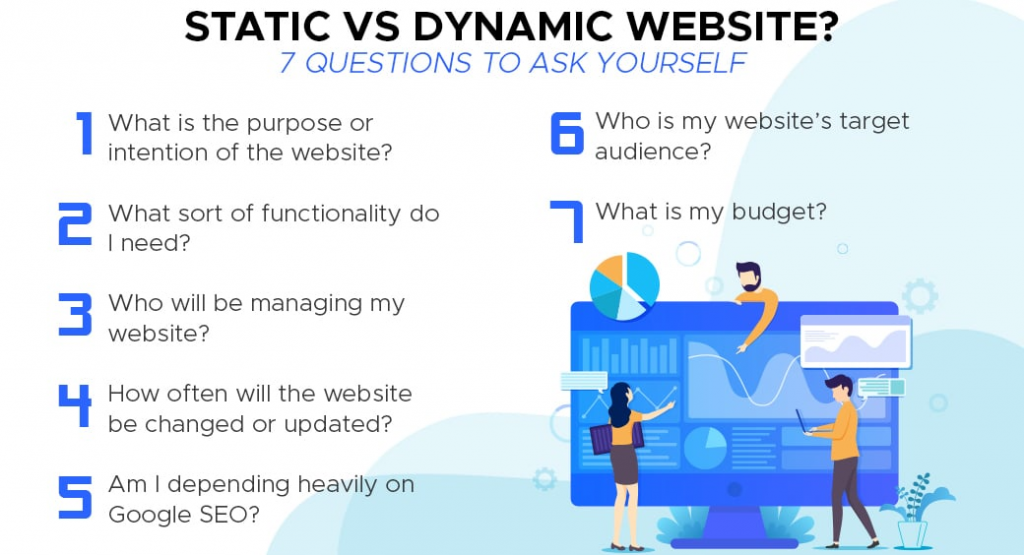
What are dynamic websites?

Websites have continuously have been evolving throughout the history of the internet. This improves user experience and brand experience. Websites today are viewable on various devices like laptops, mobiles, tablets, and so forth are optimized to become more intuitive. This has changed how people view content online. These websites now have voice assistant integrated systems for a more inclusive and user-friendly experience.
So what is a dynamic website? In simple words, it’s a website that shows a user new and different type of content every time they view it. This content changes depending on various factors like viewer age, demographic, location, language, and time.
The major difference between static and dynamic websites is that a static page requires a manual update before the content changes, whereas dynamic websites brew fresh content each time someone views the site. The process of creating a dynamic page is completed through a combination of client-side and server-side scripting.
For a more technical meaning :
Dynamic websites are websites whose pages are generated on the fly. Unlike static pages (primarily .htm/.html pages), dynamic pages are generated when a user triggers an action through that particular page.

Elements of a dynamic website
- Screen size formatting – With an expansive range of gadgets it is off-putting when websites don’t scale well on all kinds of formats. A dynamic website allows its page to appear on any kind of screen without compromising its quality and intuitive layout. This includes buttons, text, typography, images, etc to suit the viewer’s needs.
- Language specification – With various tools available, a dynamic page can change the language of the page to suit the reader’s region.
- Custom recommendations – You probably might have seen on various websites where they ask for permission to use cookies. These cookies help these websites to create a tailored experience for you on their website. Based on a user’s previous visit a user will be shown similar content and recommendations.
- Social media integration – While your social media is ever-evolving, why shouldn’t your webpage too? Social media plugins are an easy way to add new and dynamic content to your website. Site visitors can see how active your brand is. Plugins like these search engines extra content to crawl through.
- Dynamic visuals – You can add dynamic images and videos to your website too. It can be a slideshow of images that keep changing and a similar approach can be taken.
Ready to Chat About
how our
eCommerce SEO Services can grow your business?
Drop us a line today!
Static VS Dynamic: Which Is Better For SEO?
It depends. Both static and dynamic websites can serve you well for SEO purposes or damage your rankings.
Static websites are great for SEO because they have cool loading speeds, their HTML code is more understandable for SEs to index, they are more secure and more stable to a great wave of visitors. However, the user experience may be hurt because some websites are not responsive, lack handy functions and are poor in design.
On the other hand, dynamic websites are more interactive, have a lot of useful features for a personalized user experience, a lot of plugins that will help you improve your SEO (such as when using a CMS). However, you will have to take serious security measures to protect all the layers of operation starting from the server and finishing with plugins. The load speed may suffer, and there will be a need for constant code checks.

How Google uses dynamic elements
Even Google as a website uses various dynamic elements across its various platforms.
- Location – We know that Google prioritizes local businesses when a person searches for businesses. Once a local business owner optimizes their business Google will prioritize local businesses in searches rather than bigger online stores. Google uses your location to find stores near you to suit your needs.
- Search history –
- Device
- Search Ads
- Time
Reasons your site may not be included: Your pages are dynamically generated. We can index dynamically generated pages. However, because our web crawler can easily overwhelm and crash sites serving dynamic content, we limit the number of dynamic pages we index.
What are the problems that search engines face in indexing dynamic URLs?
- Search engines often consider a dynamic URL an infinite set of links.
- Since dynamic URLs find maximum application in online shopping carts, incorporating a session ID to a particular page in the site is possible. As session IDs of that particular page change, the search engine spider needs to index an infinite number of copies of the same page, which is a Herculean task for them.
- Indexing the same dynamic page might overload the search engines’ servers and therefore prevent the search engines from showing the most relevant information in the fastest possible time.
What are the options to make a search engine index your dynamic URLs?
- A static page linked to an array of dynamic pages
- Place links to the dynamic pages on the static pages, effectively submitting the static pages to the major search engines manually and according to each search engine’s recommended guidelines.
- This technique is easily implemented with a site map that fully displays all the links to the dynamic pages across the website.
- Use software – Change the dynamic URLs to static ones with the help of various software’s.
- Use CGI/Perl scripts – Path_Info or Script_Name is a variable in a dynamic application that contains the complete URL address (including the query string information). To fix this problem, you’ll need to write a script that will pull all the information before the query string and set the rest of the information equal to a variable. You can then use this variable in your URL address.
- Re-configuring your web server – Your web server enables you to turn URLs containing query strings into URLs that search engines can index.
- Optimize this static page for search engine rankings – Include a link title for all the product categories, place an appropriate “alt” tag for the product images along with a product description containing highly popular keywords relevant to your business. Submit this static page along with all the dynamic pages in various search engines, conforming to the search engine submission guidelines.
Difference between dynamic and static websites
Static websites | Dynamic websites |
Quick and easy to develop | Additional functionality |
Cheaper hosting and development | Dynamic content brings back readers/customers to site |
Content can be stagnant | Dynamic content helps in search engines |
Requires expertise for regular updates | Hosting is expensive |
Dynamic site performs slower as compared to a static site |
Types of Dynamic websites
Client-Side Scripting
Basically, client-side scripts produce client-side content. Thus, client-side content is originated on the client’s PC, but not on the server. In such cases, the customer’s browser loads the website’s content right from the server, treat the code included in a web page, and thereafter shows an updated version of content to the reader.
Server-Side Scripting
Server-side content is spawned while the page is loading. Therefore, web pages, that variate when a website is loaded, use server-side scripting. That means that websites made with the help of server-side scripting are generated at the moment when the user is downloading different webpages. The websites created with the help of such scripting are those created with the help of such CMS (Content Management System) like WordPress, Joomla, Drupal, etc.
Combination Scripting
Usually, modern dynamic websites combine the client-side and server-side scripting. The whole “new web space” is based on it because this method helps to make the server’s load time much shorter. Simply, there is no need to regenerate the whole page by the servers parser, just transmit a necessary content that is going to be changed.
Dynamic vs Static Website: Which Should You Use?
If you are a website owner or are planning to start a new website, it is important to decide whether your website should be dynamic or static. These days most people prefer Dynamic websites because they are easier to maintain in the long run. Dynamic website has more efficient data management and has an expandable functionality for future development. If you are looking for a greatly functional and ever-changing website, then a dynamic website should be your #1 option. The only downside is that they are costlier as compared to static websites and the development also takes longer. Hosting websites such as WordPress allow you to launch a dynamic website without too much hassle.
Static sites are for those who want to build an absolutely informational website. This content is read-only and non-interactive, something like a company’s brochure but online. The decision on dynamic vs static websites depends on what your website will serve, dynamic website has endless possibilities and are more complex, whereas static websites are simpler to create yet limited.

Conclusion
A dynamic website has greater possibilities as compared to a static website. Major websites today are all dynamic websites like Facebook, Google, Amazon, etc. They pull out either user-generated content or their own content when a user makes a query. Dynamic websites make up the cool web applications that exist in the world today: E-commerce, Twitter, Facebook, and any forms of social networking websites. For larger businesses, a dynamic website is more suited, in the ’90s though static websites were all the rage, many large businesses have moved over to a dynamic website.
Static websites require a lot of back and forth with a developer each time a new update has to be done. Without regular content update, SEO suffers from static websites. When compared dynamic websites are more user friendly than static websites. Dynamic websites categorized and relevant contents support the improvement of your website’s SEO.
About the Author
My name’s Semil Shah, and I pride myself on being the last digital marketer that you’ll ever need. Having worked internationally across agile and disruptive teams from San Fransico to London, I can help you take what you are doing in digital to a whole next level.



